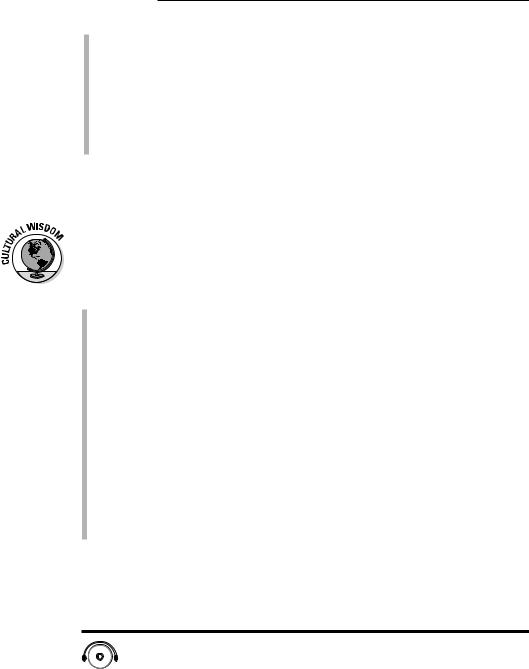
- •About the Authors
- •Dedication
- •Acknowledgments
- •Table of Contents
- •Introduction
- •About This Book
- •Conventions Used in This Book
- •Foolish Assumptions
- •How This Book Is Organized
- •Icons Used in This Book
- •Where to Go from Here
- •The French You’re Familiar With
- •Idioms and Popular Expressions
- •Key Parts of Speech
- •Cavorting with Verbs
- •Forming Sentences and Questions
- •The French Alphabet
- •Uttering Vowel and Consonant Sounds
- •Greetings: Formal and Friendly
- •Asking Questions to Get to Know People
- •Counting Your Lucky Stars: Numbers
- •Using the Calendar and Dates
- •Telling Time in French
- •Discussing Where You Live with the Verb “Habiter”
- •Discussing Daily Routine with Reflexive Verbs
- •Using Possessive Adjectives to Introduce Your Family Members
- •Basic Questions and Polite Expressions
- •Stating Your Preferences
- •Talking about Your Livelihood
- •Chatting about the Weather
- •Deciding to Keep in Touch
- •Getting Direction about Directions
- •Dining Out
- •Going to the Market
- •Going Shopping
- •Going Out with the Verb “Sortir”
- •Having Fun with the Verb “S’amuser”
- •Oh, the Places You’ll Go!
- •Making Plans with Friends
- •Making a Phone Call
- •Livin’ in the Past: Using the Past Tense
- •Playing Sports and Games
- •Going to the Beach
- •Setting Up Camp
- •Enjoying Quieter Pursuits
- •Where Do You Want to Go?
- •Getting Ready for Your Trip
- •Getting Current with Currency
- •Going to the Bank
- •Using Credit Cards and ATMs
- •Getting through the Airport
- •Navigating Buses, Trains, and Subways
- •Getting Around by Car
- •Finding Accommodations
- •Checking In to a Hotel
- •Checking Out of a Hotel
- •Getting Help Fast
- •Getting Medical Help
- •Handling Legal Matters
- •Label the Things in Your House
- •Write Your Shopping Lists in French
- •Listen to French Music
- •Watch French Movies
- •Tune in to TV5
- •Read French Publications
- •Take a Class
- •Join a French Association
- •Join an Online Chat or Pen Pal Forum
- •Using “Tu” When You Mean “Vous”
- •Using “Bonne nuit!” for Good-Bye
- •Using “Garçon” or “Porteur” to Address Service Staff
- •Saying “Je suis excité(e)” to Indicate Excitement
- •Saying “Je suis chaud(e)/froid(e)” to Say You’re Hot or Cold
- •Saying “Je suis plein/e” to Mean You’re Full
- •Using “de la glace” to Request Ice
- •Using “Je suis . . . ans” to Tell Your Age
- •Asking for Change with “J’ai besoin de change”
- •Using the Verb “Visiter” in Reference to People
- •“À mon avis”
- •“C’est pas vrai”
- •“Avec plaisir”
- •“C’est génial”
- •“À votre santé”
- •“À vos souhaits”
- •“Quelle horreur!”
- •“À bientôt”
- •“Passez-moi un coup de fil!”
- •“On y va!” or “Allons-y!”
- •“Je n’en sais rien”
- •“Je n’en reviens pas”
- •“Ça vaut la peine”
- •“C’est pas grave”
- •“N’importe”
- •“Tu cherches midi à 14h”
- •“Prenons un pot!”
- •Regular French Verbs
- •Auxiliary French Verbs
- •Track Listing
- •Customer Care
- •Index

Chapter 5
Talking about Your Home, Family, and Daily Routine
In This Chapter
Talking about where you live and the rooms in your house
Using the reflexive verb form to talk about your daily routine
Discussing meals with the verbs manger, prendre, and boire
Introducing family members with possessive adjectives
If you’re like most people, home and family are at the center of your life, and they provide numerous topics of daily conversation. Just try counting
the number of times a day you mention your home and family to your coworkers or friends. The same is true of people everywhere, which is why these topics are often the first you tackle when you learn a new language. Furthermore, these topics of conversation are often the first things people who don’t know you ask about. They may ask you where you live, whether you have siblings, whether you’re married or single, and so on. With the vocabulary and information in this chapter, you’ll be ready to answer these questions and perhaps even ask a few of your own.
Discussing Where You Live with the Verb “Habiter”
In French, two verbs correspond to the English to live: habiter (ah-bee-tey) and vivre (vee-vruh). Most of the time, these verbs are interchangeable, but habiter refers to space, whereas vivre refers to time as well as space. For example, to say We live in the 21st century, you use vivre: Nous vivons au vingt-et-unième siècle (nooh vee-vohN oh vaN-tey-ew-nee-ehm syeh-kluh). But when you talk about where you live, you use the verb habiter, as these examples show:
www.ATIBOOK.ir

68 |
Part I: Getting Started |
J’habite dans une maison. (zhah-beet dahN-zewn meh-zohN.) (I live in a house.)
J’habite dans un appartement. (zhah-beet dahN-zuhN-nah-pahr-tuh- mahN.) (I live in an apartment.)
Nous habitons à la campagne/en ville. (nooh-zah-bee-tohN ah lah kahN- pah-nyuh/ahN veel.) (We live in the country/city.)
Nous habitons en banlieue. (nooh-zah-bee-tohN ahN bahN-lyuh.) (We live in the suburbs.)
Vivre is an irregular verb, so when you talk about space, stick to habiter for now because it is regular and easy to use.
Regardless of whether you live in a private house or an apartment, various rooms have a special and particular function. The following list introduces les pièces de la maison (ley pyehs duh lah meh-zohN) (the rooms of a house):
le salon (luh sah-lohN) (living room)
la cuisine (lah kwee-zeen) (kitchen)
la chambre (lah shahN-bruh) (bedroom)
la salle de bains (lah sahl duh baN) (bathroom)
The following sections introduce the basic rooms of a house or apartment and list the furniture and appliances each may contain.
In France, the stories of a house or an apartment are counted differently than in the United States. The French consider the first floor as the ground floor, le rez-de-chaussée (luh reyd-shoh-sey) (street level), and start counting after that. Therefore, what we would consider to be the second floor is actually the
first floor — le premier étage (luh pruh-myey-rey-tahzh) — in France; the third floor is le deuxième étage (luh duh-zee-ehm ey-tahzh), and so forth.
In “le salon” (the living room)
The French have two names for the living room: le salon, which is a more formal living room, and la salle de séjour (lah sahl duh sey-zhoohr) — le séjour (luh sey-zhoohr) for short — meaning a casual family room. The French also use the Anglicism le living (luh lee-veeng). Here is a list of furniture that you’d normally find in a living room:
un sofa/un canapé (uhN soh-fah/uhN kah-nah-pey) (sofa/couch)
un fauteuil (uhN foh-tohy) (arm chair)
un tapis (uhN tah-pee) (rug)
une moquette (ewn moh-keht) (wall-to-wall carpet)
www.ATIBOOK.ir

Chapter 5: Talking about Your Home, Family, and Daily Routine |
69 |
une table de salon (ewn tah-bluh duh sah-lohN) (coffee table)
une lampe (ewn lahmp) (lamp)
des rideaux (dey ree-doh) (curtains, drapes)
une télévision/une télé (ewn tey-ley-vee-zyohN/ewn tey-ley) (TV)
In “la cuisine” (the kitchen)
The kitchen is the heart of many homes. Not only is it the place to prepare and eat home cooked meals, but it is also the place where family and friends gather to discuss their day, to make plans for the weekend, or to talk about the weather. Here is a list of what you may find in a typical kitchen:
une cuisinière (ewn kwee-zee-nyehr) (stove)
un réfrigérateur/un frigo (uhN rey-free-zhey-rah-tuhr/uhN free-goh) (refrigerator/fridge)
un évier (uhN-ney-vyey) (kitchen sink)
un comptoir (uhN kohN-twahr) (counter)
un four à micro-ondes (uhN foohr ah mee-kroh-ohNd) (microwave oven)
un lave-vaisselle (uhN lahv-veh-sehl) (dishwasher)
une table de cuisine (ewn tah-bluh duh kwee-zeen) (kitchen table)
des chaises (dey shehz) (chairs)
In France, the kitchen is not usually counted as part of the rooms of the house. If you’re looking in the French classifieds to rent an apartment or a house, for example, and see un appartement à trois pièces (uhN-nah-pahr-tuh-mahN
ah trwah pyehs), it means a 3-room apartment, indicating a living room and two bedrooms.
In “la chambre” (the bedroom)
Your bedroom is your own personal space that reflects your personality and taste. It’s also the place you can go when you need some privacy. Here is a list of some of the things you may find in a bedroom:
un lit (uhN lee) (bed)
des lits jumeaux (dey lee zhew-moh) (twin beds)
un lit d’une personne (uhN lee dewn pehr-sohhn) (single bed)
un lit de deux personnes (uhN lee duh duh pehr-sohhn) (double bed)
une commode (ewn koh-mohhd) (dresser)
www.ATIBOOK.ir

70 |
Part I: Getting Started |
une armoire (ewn ahr-mwahr) (armoire)
une table de nuit (ewn tah-bluh duh nwee) (nightstand)
un réveil (uhN rey-vehy) (alarm clock)
une couverture (ewn kooh-vehr-tewr) (blanket)
un oreiller (uhN-noh-rey-yey) (pillow)
des draps (dey drah) (sheets)
In “la salle de bains” (the bathroom)
In French, there’s a difference between la salle de bains and les toilettes (ley twah-leht) (toilet). La salle de bains literally means bathroom, or a place to bathe. It does not necessarily have a toilet. If you are looking for the restroom, be sure to ask for either les toilettes or les W.C. (ley vey sey) (water closet). Here are some things commonly found in la salle de bains:
une baignoire (ewn beh-nywahr) (bathtub)
une douche (ewn doohsh) (shower)
un lavabo (uhN lah-vah-boh) (sink)
une serviette (ewn sehr-vyeht) (towel)
un miroir (uhN mee-rwahr) (mirror)
une brosse (ewn brohs) (hairbrush)
un peigne (uhN peh-nyuh) (comb)
un rasoir (uhN rah-zwahr) (razor)
une brosse à dents (ewn brohs ah dahN) (toothbrush)
du dentifrice (dew dahN-tee-frees) (toothpaste)
du savon (dew sah-vohN) (soap)
You also often find un bidet (uhN bee-deh) (a bidet) in French bathrooms.
Talkin’ the Talk
Suzanne, a student at the Sorbonne, is looking for a roommate to share her rent and other expenses. She has posted an ad and found another student who is interested in sharing the apartment. The two meet to discuss the situation. (Track 4)
www.ATIBOOK.ir

Chapter 5: Talking about Your Home, Family, and Daily Routine |
71 |
Suzanne: Où habites-tu maintenant?
ooh ah-beet-tew maN-tuh-nahN?
Where do you live now?
Agnès: J’habite en banlieue mais je voudrais être plus près de l’université. Où se trouve l’appartement? zhah-beet ahN bahN-lyuh meh zhuh vooh-dreh ehtruh plew preh duh lew-nee-vehr-see-tey. ooh suh troohv lah-pahr-tuh-mahN?
I live in the suburbs, but I would like to be closer to the university. Where is the apartment located?
Suzanne: L’appartement se trouve dans le 5e arrondissement, près de la Sorbonne.
lah-pahr-tuh-mahN suh troohv dahN luh saNk-ee-ehm ah-rohN-dees-mahN, preh duh lah sohr-bohhn.
The apartment is in the 5th district, near the Sorbonne.
Agnès : Combien de pièces y a-t-il? kohN-byaN duh pyehs ee ah-teel?
How many rooms are there?
Suzanne: Il y a trois pièces: un séjour, deux chambres et la cuisine. eel ee ah trwah pyehs: uhN sey-zhoohr, duh shahNbruh ey lah kwee-zeen.
There are three rooms: a living room, two bedrooms and the kitchen.
Agnès: Est-ce que l’appartement est meublé? ehs-kuh lah-pahr-tuh-mahN eh muh-bley?
Is the apartment furnished?
Suzanne : Oui, il y a un canapé, un fauteuil, une table de salon et une télévision dans le séjour et un lit, une armoire et une table de nuit dans la chambre.
wee, eel ee ah uhN kah-nah-pey, uhN foh-tohy, ewn tah-bluh duh sah-lohN ey ewn tey-ley-vee-zyohN dahN luh sey-zhoohr ey uhN lee, ewn ahr-mwahr ey ewn tah-bluh duh nwee dahN lah shahN-bruh.
Yes, there is a sofa, a chair, a coffee table and a television in the living room and a bed, an armoire, and a nightstand in the bedroom.
Agnès: Est-ce que la cuisine est aménagée?
ehs-kuh lah kwee-zeen eh-tah-mey-nah-zhey?
Is the kitchen equipped?
www.ATIBOOK.ir

72 |
Part I: Getting Started |
|
|
|
|
|
|
|
|||
|
|
Suzanne: |
Oui, il y a un frigo, une cuisinière et |
||
|
|
|
|
un four à micro-ondes. |
|
|
|
|
|
wee, eel ee ah uhN free-goh, ewn |
|
|
|
|
|
kwee-zee-nyehr ey uhN foohr ah |
|
|
|
|
|
mee-kroh-ohNd. |
|
|
|
|
|
Yes, there is a fridge, a stove, and |
|
|
|
|
|
a microwave. |
|
|
|
Agnès: |
Combien est le loyer? |
||
|
|
|
|
kohN-byaN eh luh lwah-yey? |
|
|
|
|
|
How much is the rent? |
|
|
|
Suzanne: |
550 euros par mois. |
||
|
|
|
|
saNk sahN saNk-ahNt uh-roh |
|
|
|
|
|
pahr mwah. |
|
|
|
|
|
550 euros a month. |
|
|
|
Agnès: |
C’est parfait! |
||
|
|
|
|
seh pahr-feh! |
|
|
|
|
|
It’s perfect! |
|
|
|
|
|
|
|
Words to Know
la banlieue |
lah bahN-lyuh |
the suburbs |
près de |
preh duh |
near, close to |
combien de |
kohN-byaN duh |
how many |
meublé |
muh-bley |
furnished |
aménagé |
ah-mey-nah-zhey |
equipped |
le loyer |
luh lwah-yey |
the rent |
par mois |
pahr mwah |
per month |
www.ATIBOOK.ir
